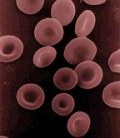 A, B, AB, or O?
A, B, AB, or O?
A blood type (also called a blood group) is a classification of blood based on the presence or absence of inherited antigenic substances on the surface of red blood cells (RBCs). These antigens may be proteins, carbohydrates, glycoproteins, or glycolipids, depending on the blood group system, and some of these antigens are also present on the surface of other types of cells of various tissues. Several of these red blood cell surface antigens, that stem from one allele (or very closely linked genes), collectively form a blood group system.
The ABO system is the most important blood group system in human blood transfusion. The associated anti-A antibodies and anti-B antibodies are usually “Immunoglobulin M”, abbreviated IgM, antibodies. ABO IgM antibodies are produced in the first years of life by sensitization to environmental substances such as food, bacteria and viruses. The “O” in ABO is often called “0” (zero/null) in other languages.
A quite literally vital question when a blood transfusion is required and normally blood type is determined using an antibody and optical examination. However, Austrian researchers at the University of Vienna have developed a novel approach that is much simpler and side-steps expensive antibodies. Their technique is based on the blood-type-specific adsorption of red blood cells (erythrocytes) on a plastic surface “embossed” on the molecular scale.
Production of the analytical chips needed for this method is a simple and inexpensive process: quartz microbalances (tiny piezoelectric quartz crystals) are coated with a wafer-thin film of polyurethane. Erythrocytes of a specific blood type in liquid are placed on a slide and stick to its surface, forming the embossing “stamp”. The polymer is cured to harden it and the cells washed off. The ebmossed plastic surface now contains a large number of tiny impressions with indentations shaped like the antigens on the surface of the blood cells.
If a sample of blood is then placed on the chip, the erythrocytes will preferentially settle into those impressions with a matching shape. The resulting increase in mass is measured with the incredibly sensitive quartz microbalance.
The shape and size of the erythrocytes are the same for all blood types, so how can they be differentiated by these indentations? ‘The outer form is not the deciding factor,’ says team leader Franz Dickert, ‘instead, it is the differences in the surfaces of the different blood types.’ There are sugar-like molecular fragments on the surface of the cells that differentiate the blood types.
‘Despite a noticeable cross-sensitivity for the other blood types, determination of the blood type by the embossed plastic films is unambiguous,’ says Dickert, ‘because the strongest sensor signal comes from the microbalance that carries the impressions corresponding to the blood type of the sample.’
Dickert and colleagues publish details of their technique in Angew Chem, 2006, 45, 2626-2629
 A, B, AB, or O?
A, B, AB, or O?